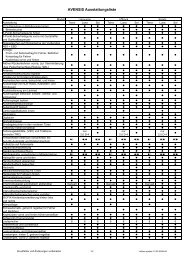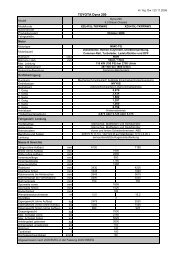tal leadership by maintaining the performance of more than ... - Toyota
tal leadership by maintaining the performance of more than ... - Toyota
tal leadership by maintaining the performance of more than ... - Toyota
Create successful ePaper yourself
Turn your PDF publications into a flip-book with our unique Google optimized e-Paper software.
Prius Plug-in Hybrid in front <strong>of</strong> <strong>the</strong> city hall in Paris Prius Plug-in Hybrid project in Strasbourg<br />
PHEV display<br />
Charging Infrastructure – Room for Improvement<br />
The charging infrastructure plays a key role and <strong>the</strong>re is an opportunity to develop <strong>the</strong><br />
infrastructure fur<strong>the</strong>r and to make it <strong>more</strong> readily available. Enhancing PHEV <strong>performance</strong><br />
also requires users to change <strong>the</strong>ir habits. We can see from <strong>the</strong> interim results that users<br />
recharge roughly 0.9 times/day and that while <strong>the</strong> procedure to charge <strong>the</strong> vehicle remains<br />
easy, <strong>the</strong> cable ergonomics remain a concern in terms <strong>of</strong> handling.<br />
Users need to get accustomed to charging <strong>the</strong>ir vehicles. This is an entirely new habit,<br />
which still appears as constraining for a few users. From <strong>the</strong> initial results it appears that<br />
charging occurs mainly at private parking charging points (91%) and at <strong>the</strong> workplace (72%).<br />
Recharging usually takes place during peak hours, at 08:00 when <strong>the</strong> users reach <strong>the</strong>ir<br />
workplace or at 19:00 when back at home.<br />
There are several key learnings for <strong>the</strong> Urban Community <strong>of</strong> Strasbourg. Despite <strong>of</strong>fering<br />
free electricity and convenient city parking spots, <strong>the</strong> usage <strong>of</strong> <strong>the</strong> 27 public road and public<br />
parking lot charging points was low. User surveys underline <strong>the</strong> need for clear communication<br />
on <strong>the</strong> locations <strong>of</strong> charging points and <strong>the</strong>ir operational status.<br />
Looking Forward<br />
In summary, we can see that <strong>the</strong> PHEV meets <strong>the</strong> expectations <strong>of</strong> users and provides tangible<br />
fuel savings while providing genuine driving pleasure and daily ease <strong>of</strong> use. It also encourages<br />
users to adopt a <strong>more</strong> eco-friendly driving style. Additionally we can identify some key factors<br />
to optimise environmen<strong>tal</strong> <strong>performance</strong> <strong>by</strong> :<br />
Ensuring frequent recharging, in line with usage <strong>of</strong> <strong>the</strong> vehicle<br />
Recharging <strong>the</strong> battery fully when recharging<br />
Increasing user awareness and training to allow customers to maximise <strong>the</strong> vehicle<br />
<strong>performance</strong>.<br />
The interim results and recommendations provide valuable input towards <strong>the</strong> launch <strong>of</strong> <strong>the</strong><br />
PHEV in 2012, with planned sales <strong>of</strong> 50,000 units globally, and 6,000 in Europe.<br />
�<br />
Case Study<br />
<strong>Toyota</strong> European Sustainability Report 2011 I Environmen<strong>tal</strong> Performance<br />
15

















